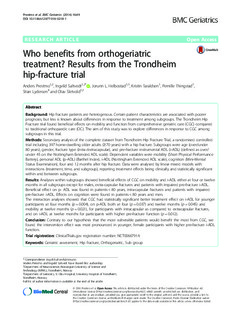| dc.description.abstract | Background:
Hip fracture patients are heterogenous. Certain patient characteristics are associated with poorer prognosis, but less is known about differences in response to treatment among subgroups. The Trondheim Hip Fracture trial found beneficial effects on mobility and function from comprehensive geriatric care (CGC) compared to traditional orthopaedic care (OC). The aim of this study was to explore differences in response to CGC among subgroups in this trial.
Methods:
Secondary analysis of the complete dataset from Trondheim Hip Fracture Trial, a randomised controlled trial including 397 home-dwelling older adults (≥70 years) with a hip fracture. Subgroups were age (over/under 80 years), gender, fracture type (intra-/extracapsular), and pre-fracture instrumental ADL (i-ADL) (defined as over/under 45 on the Nottingham Extended ADL scale). Dependent variables were mobility (Short Physical Performance Battery), personal ADL (p-ADL) (Barthel Index), i-ADL (Nottingham Extended ADL scale), cognition (Mini-Mental Status Examination), four and 12 months after hip fracture. Data were analysed by linear mixed models with interactions (treatment, time, and subgroup), reporting treatment effects being clinically and statistically significant within and between subgroups.
Results:
Analyses within subgroups showed beneficial effects of CGC on mobility and i-ADL either at four or twelve months in all subgroups except for males, extra-capsular fractures and patients with impaired pre-fracture i-ADL. Beneficial effect on p- ADL was found in patients < 80 years, intra-capsular fractures and patients with impaired pre-fracture i-ADL. Effects on cognition were found in patients < 80 years and men.
The interaction analyses showed that CGC had statistically significant better treatment effect on i-ADL for younger participants at four months (p = 0.004), on p-ADL both at four (p = 0.037) and twelve months (p = 0.045) and mobility at twelve months (p = 0.021), for participants with intracapsular as compared to extracapsular fractures, and on i-ADL at twelve months for participants with higher pre-fracture function (p = 0.012).
Conclusion:
Contrary to our hypothesis that the most vulnerable patients would benefit the most from CGC, we found the intervention effect was most pronounced in younger, female participants with higher pre-fracture i-ADL function. | nb_NO |

